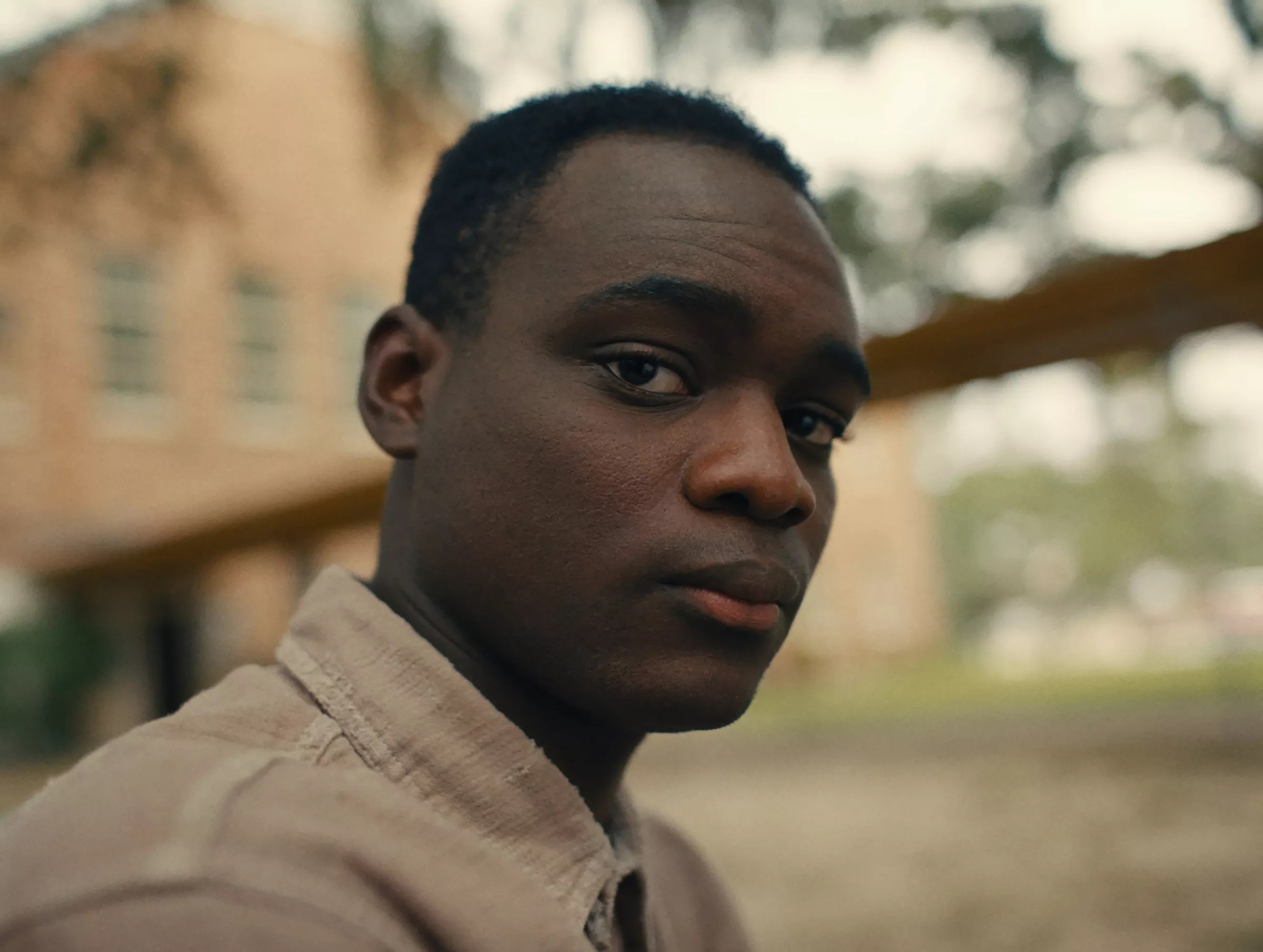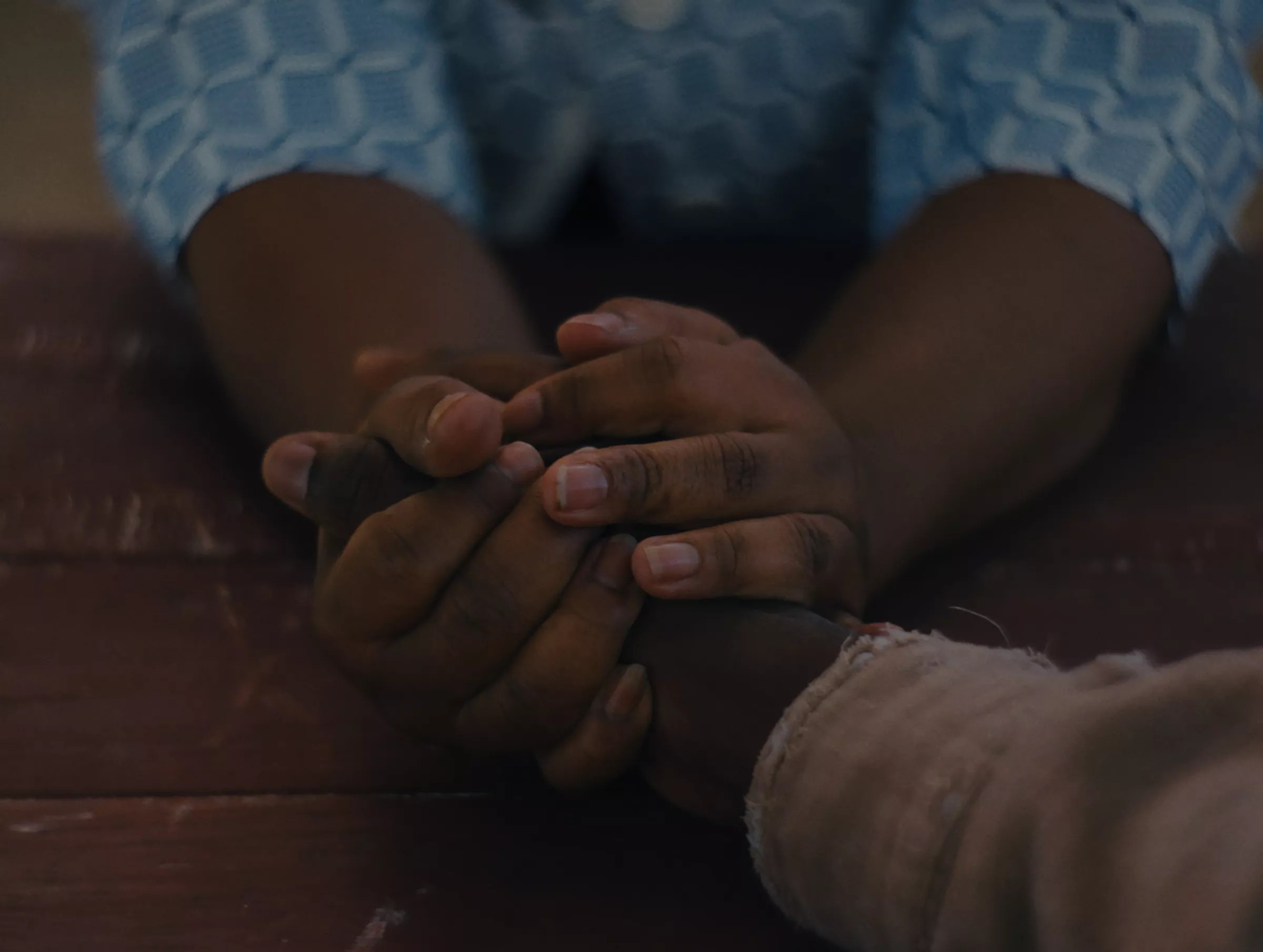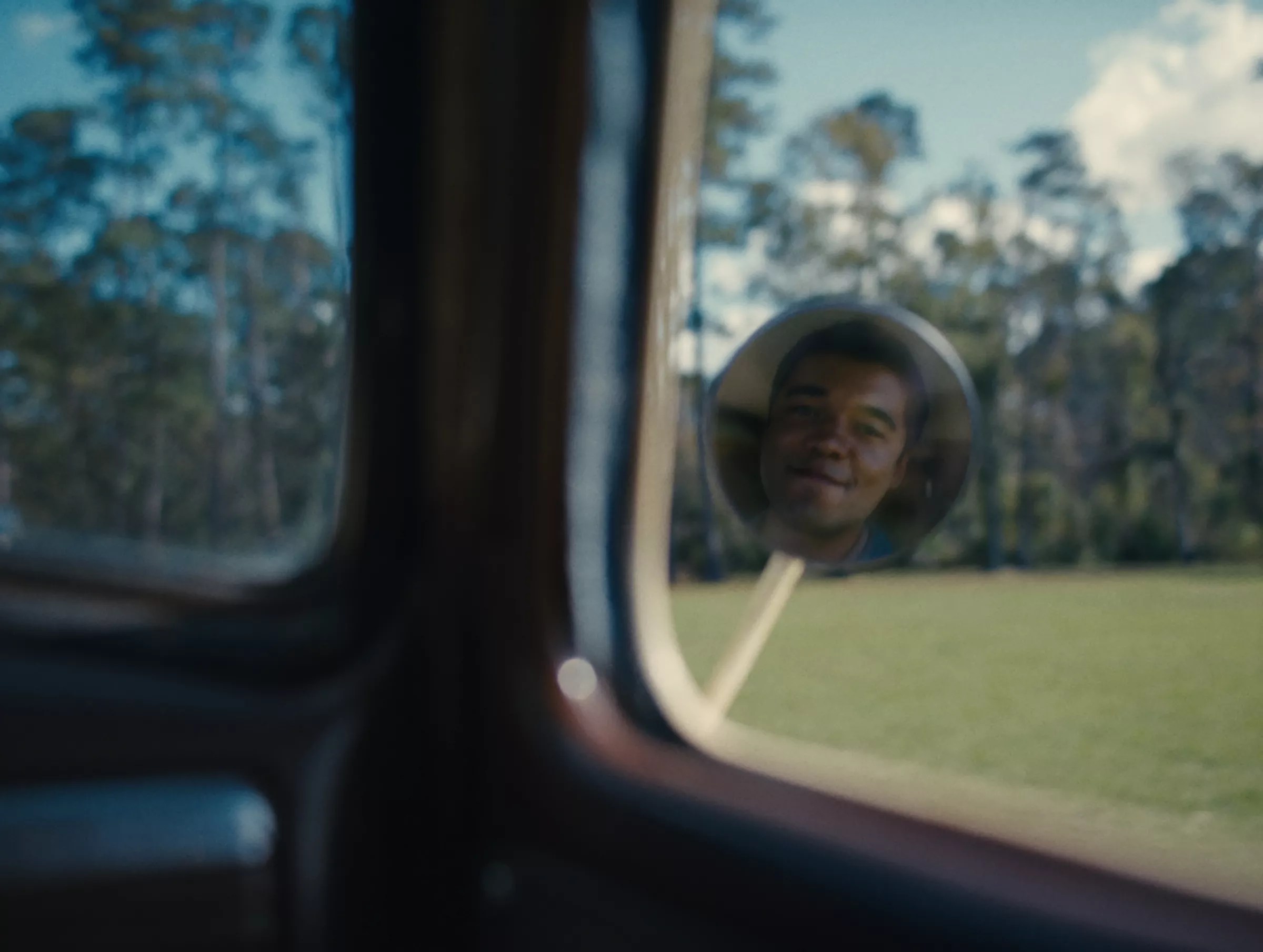
Orion Pictures photo

Audio By Carbonatix
RaMell Ross came across plenty of disturbing facts while making his new film Nickel Boys about two young men’s attempts to survive in a juvenile prison in Jim Crow-era Florida. In terms of sheer outrageous depravity, however, one takes the cake.
“Across the South, Black children used to be used as alligator bait,” he says. “And in the montage, we put in an actual postcard – that we didn’t create, that exists in the world – of the promotion of Black children as alligator bait, because it was so common that it wasn’t necessarily frowned upon.”
Despite the evidence, the anecdote seems almost too comically evil to be true, especially somewhere like Florida, a place people associate more with white-sand beaches and theme parks than segregation and slavery. The state’s authorities would seemingly like to keep it that way: Governor Ron DeSantis’ revisionist education policies have done much to disrupt the teaching of Black history in the state, forcing its students to learn outside of school. Yet the brutality of institutional racism often lies hidden under our very feet. Such was the case in Marietta, just outside Tallahassee, where in 2012, University of South Florida researchers found the unmarked graves of some 55 murdered students at the former Arthur G. Dozier School for Boys, a notorious juvenile reformatory that closed just a year earlier.
For decades, the survivors of Dozier, calling themselves the White House Boys after the building where corporal punishment was dispensed, had recounted stories of beatings, rape, and killings at the school, which was segregated until 1966. Black students received the worst treatment, including whippings and other physical torture. Because of their bravery, the story of Dozier is more visible than ever. Colson Whitehead’s 2019 novel The Nickel Boys, the source material for Ross’ film, takes place in an almost identical setting, the Dozier analogue Nickel Academy. The film follows Elwood (Ethan Herisse), a bright young student in Tallahassee involved in the local Civil Rights Movement, as he gets whisked away unjustly to the brutal academy. There, he meets Turner (Brandon Wilson), a fellow inmate from the wrong side of the tracks, and the two form a bond that helps them stay alive in the reformatory as Elwood’s Aunt Hattie (Aunjanue Ellis-Taylor) attempts to free him.
This year, make your gift count –
Invest in local news that matters.
Our work is funded by readers like you who make voluntary gifts because they value our work and want to see it continue. Make a contribution today to help us reach our $30,000 goal!
Ross’ work doesn’t extend to simply visualizing the story. In a stunning feat for an American narrative film, Nickel Boys is shot entirely in point of view, showing us exactly what Elwood and Turner see. We literally look through their eyes, see their memories and thoughts, and perceive their world from their perspective. The technique is coupled with inserts of reference material: Vintage footage of Martin Luther King Jr. and the moon landing, clips from the 1958 Sidney Poitier-starring prison drama The Defiant Ones, images from the actual reports on the Dozier School prepared by USF researchers, and yes, that alligator bait postcard. The film is in contention for the Oscars and received a Gotham Award for Best Director, multiple Golden Globes nominations, and other nods. New Times named it one of the best movies of 2024.
I spoke to Ross about Nickel Boys, its inspirations, and the process of crafting one of the year’s truly unique films.

Director RaMell Ross on the set of his film Nickel Boys.
Photo by L. Kasimu Harris
When did you first encounter the novel? What about it and the story of the Dozier School (Nickel Academy in the movie) made you want to make this film?
I have an art practice, and I make art and photography and stuff. My art studio manager, this guy named Bobby Davis, is from Florida. I remember when Dede [Gardner, producer] and Jeremy [Kleiner, producer] asked me to take a look at the book. They sent me a PDF – this is before the book came out – and I print out a little copy of it, I’m walking around with it in our studio, and (Bobby’s) like, “What’s that?” I was like, “Oh, I just met with these producers about maybe adapting this book.” “What book?” I tell him what it’s about and he’s like, “Oh, Dozier! I almost went there when I was a kid.” Bobby was like a “bad kid,” obviously. Well, not obviously, but because of family reasons. But he was almost sent there. His mom stopped it at the last minute. But that just kind of speaks to how recent it is.
I came across the book through [the production company] Plan B. I wanted to adapt it because it seemed like an opportunity to populate that time period and the boys’ lives with – it sounds metaphoric – but populate it with life. To give them life, to allow them to see. And for us to be able to see with them. It seemed like an act that that time, the visualization of that time period, needed.
I’m interested in the research process for the film – how much you knew about Dozier before you made the film, before you encountered the book, if at all. Did you speak to any survivors? Did you incorporate this sort of real-life material into the film at all? Elwood himself is doing this research process in the world of the film. So, I think it’s part of the text, in a way.
I hadn’t heard of it, and it’s really embarrassing, you know? And I’m unsure if I should be embarrassed or if our news cycle should be embarrassed, but I hadn’t heard of it, and immediately, of course, went to start doing the research, and you come across the Dozier document. You come across the book, The Boys of the Dark by Robin Fisher, which is, of course, the nonfiction account of the White House and the Dozier School. I think my research stayed close to what Colson [Whitehead] did. My co-writer Jocelyn Barnes and I used his index of research places, went there, and then just watched other reform school films and stuff like The Defiant Ones, to see how cinema has treated these types of stories.

Aunjanue Ellis-Taylor stars as Hattie and Ethan Herisse as Elwood in director RaMell Ross’ Nickel Boys.
Orion Pictures photo
I think the fact that you hadn’t heard of it really speaks to how that kind of history is suppressed, especially in Florida. The state tries to portray itself as this sort of paradise vacation destination, and that disguises a lot of the horrific racist things that went on here for generations. Did those sort of preconceptions factor into the film’s development at all? How are you trying to integrate the idea of Florida and what it is versus what it pretends to be into the film?
We didn’t want to over-emphasize the location. And while that may seem counterintuitive, from our research we realized that this is like a worldwide phenomenon, and we’re closer to the ones that happen in Canada and the ones that happen in the States. But we imagine there’s a version in which you’re so specific – visually and geographically, tropically specific – that it makes it seem like it happens there. Like, “Oh, that type of landscape, those types of people, that location.” And so we decided to kind of have the aesthetic feel loosely but specifically like the historic South. So we’re almost painting the entire Black Belt region, as if it could happen in any one of those spots, and that was quite useful. But we also maintained some of the Floridian phenomena, like the alligator. A person that is from Florida and sees that moment is like, “I dunno, that actually happens,” like when they’re just walking down the street. Of course, we have the oranges in there, that are both symbolic and maybe a bit visceral, especially at the beginning. But I think, more importantly for the film, it was important to at least hint at the relationship between the school and its integration into the business of the town and the selling of Dozier’s goods. We thought that doing those things with a specific Florida backdrop might be a little problematic.

Orion Pictures photo
Actually, now that you mention it, I was curious about the alligator that the characters encounter in the film. Did you want that to be interpreted as some sort of metaphorical symbol or just something that exists in the world? It seems to me like a representation of the sort of threats that people encounter or Black people specifically within Florida. But you also see that actually represented in the film in the form of cops and authorities.
Well, you’re spot on, and that’s the hope for moments like that in the film. They’re sort of built to be very porously interpretive. So I think you’re not allowed to dismiss it, because it actually happens. It’s something that’s true. But if you want it to be a metaphor, if you think in terms of animals and symbolism, and you have notions of the sort of violence and the reptilian nature of some systems – the way in which they chew you up, how the nature of the system is reptilian, some could say – then a person could get there. And then, if you’re a person of history, and I’m not even calling myself necessarily one – I came across this fact, you know, maybe four years ago, before I got the Dozier script, and I couldn’t believe I didn’t know this. In Florida, North Florida, and across the South, Black children used to be used as alligator bait. That’s how they would get children out of the water. And it’s super well-documented in tons of newspapers. And in the montage, we put in an actual postcard – that we didn’t create, that exists in the world – of the promotion of Black children as alligator bait, because it was so common that it wasn’t necessarily frowned upon.
I didn’t even know that, it’s really shocking and horrific.
Yeah, but this is that eraser of history that you’re saying is key to the state, unfortunately.
These sort of time-lapse and collage elements that you put in, I interpret it as this kind of collage of memories from the boys. I don’t like asking if that’s accurate, necessarily, but I’m curious about what you think of that interpretation.
I love that interpretation. The form of the film is supposed to feel like it’s evolving in front of you in the way that consciousness does, in the way that dreams do, in the way that we exist in the world. And the editing and and the use of images, aside from their deep conceptual intention, is supposed to be an attempt at approximating consciousness, which sounds crazy, right? It’s an absurd thing to attempt, but if you can even come close, then you’re connecting with the unconscious in a really, really fascinating way. And in that way it’s open intentionally to the types of interpretation that you’re offering. I think there’s a couple different clear ways to read it, at least, that we’ve articulated to ourselves, and one of them that we’re happy with is the one that you mentioned.

Aunjanue Ellis-Taylor stars as Hattie in director RaMell Ross’ Nickel Boys.
Orion Pictures photo
As long as we’re talking about the form of the film, obviously, there’s the POV element. At what point did the idea of shooting entirely in first person enter the production process, and what made you want to use that formal structure to tell this story?
The film was entirely conceived in point of view. It was the first idea I had after I read it. You know, it was the idea in the two-page approach, and then in the treatment itself, which Jocelyn Barnes and I built out as an edit of the film. We were writing very visually, and to take POV seriously, you have to then think about where the boys look and the meaning that’s made in that, and trying to express their personalities based on the way that they’re controlling the visual field. The whole development process was in point of view. It was always conceived to shoot the film as oners. I don’t know if this movie could have been made, or I could have convinced the producers to make it, if they couldn’t literally see or feel a bit of what we wanted.
I think when we’re talking about the actual source material, the Dozier School for Boys, even separate from Colson’s mythology and the characters that he created, I think that there’s almost no more powerful of a gesture than to give them life, give them a camera, take a camera into their bodies, and allow them to allow us to experience the world with them. That’s kind of the core of it. I’ve always been interested in what Black subjectivity truly looks like. It’s not something that can ever be absolute or final. And I think the camera can really approach that complexity, especially when we’re dealing with point of view.
Nickel Boys. Starring Ethan Herisse, Brandon Wilson, Daveed Diggs, and Aunjunae Ellis-Taylor. Screenplay by RaMell Ross and Joslyn Barnes. Directed by RaMell Ross. 140 minutes. Rated PG-13. Check for showtimes at miaminewtimes.com/miami/movietimes.